Water Footprint of Food Consumption by Chinese Residents
Abstract
1. Introduction
2. Methods and Data
2.1. Methods
2.1.1. Water Footprint Model of Residents’ Food Consumption
2.1.2. Food Consumed
2.1.3. Water Footprint Structure
2.2. Data
2.2.1. Water Footprint Per Unit of Food Consumed
2.2.2. Residents’ Food Consumption
3. Results and Discussion
3.1. Comprehensive Analysis
3.2. Water Footprint of Urban and Rural Residents’ Food Consumption
3.3. Per Capita Water Footprint of Residents’ Food Consumption
3.4. Water Footprint Structure of Residents’ Food Consumption
3.5. Water Footprint of Consumption of Each Food
4. Conclusions
Author Contributions
Funding
Conflicts of Interest
References
- United Nations World Water Assessment Programme. The United Nations World Water Development Report 2015: Water for a Sustainable World; UNESCO: Paris, France, 2015. [Google Scholar]
- Brown, L. The future of growth. In State of the World 1998. A Worldwatch Institute Report on Progress toward a Sustainable Society; The Worldwatch Institute: New York, NY, USA, 1998; pp. 3–20. [Google Scholar]
- Flavin, C. Energy for the 21st Century; World Bank Energy Week; World Scientific: Singapore, 1999. [Google Scholar]
- Feffer, J. We Are all North Koreans Now? Available online: http://www.worldsecuritynetwork.com/Koreas/Feffer-John/Are-we-all-North-Koreans-now (accessed on 10 September 2018).
- World Economic Forum. The Global Risks Report 2017, 12th ed.; World Economic Forum: Geneva, Switherland, 2017. [Google Scholar]
- United Nations World Water Assessment Programme. The United Nations World Water Development Report 2016: Water and Jobs; UNESCO: Paris, France, 2016. [Google Scholar]
- United Nations World Water Assessment Programme. The United Nations World Water Development Report 2014: Water and Energy; UNESCO: Paris, France, 2014. [Google Scholar]
- World Bank. High and Dry: Climate Change, Water, and the Economy; World Bank: Washington, DC, USA, 2016. [Google Scholar]
- Dobner, P. Wasserpolitik: Zur Politischen Theorie, Praxis und Kritik Globaler Governance; Suhrkamp: Berlin, Germany, 2010. [Google Scholar]
- Allan, J.A. Fortunately there are substitutes for water otherwise our hydropolitical futures would be impossible. In Priorities for Water Resources Allocation and Management; Overseas Development Administration (ODA): London, UK, 1993; pp. 13–26. [Google Scholar]
- Arid Land Newsl. Available online: https://cals.arizona.edu/OALS/ALN/aln45/allan.html (accessed on 17 October 2019).
- Hoekstra, A.Y.; Hung, P.Q. Virtual Water Trade: A Quantification of Virtual Water Flows between Nations in Relation to International Crop Trade; Value of Water Research Report Series No. 11; UNESCO-IHE: Delft, The Netherlands, 2002. [Google Scholar]
- Hoekstra, A.Y. Virtual Water Trade: An Introduction; Hoekstra, A.Y., Ed.; UNESCO-IHE: Delft, The Netherlands, 2003; pp. 13–23. [Google Scholar]
- Chapagain, A.K.; Hoekstra, A.Y. Water Footprints of Nations; Value of Water Research Report; UNESCO-IHE: Delft, The Netherlands, 2004. [Google Scholar]
- Chapagain, A.K.; Hoekstra, A.Y. The global component of freshwater demand and supply: An assessment of virtual water flows between nations as a result of trade in agricultural and industrial products. Water Int. 2008, 33, 19–32. [Google Scholar] [CrossRef]
- Chapagain, A.K.; Hoekstra, A.Y.; Savenije, H.H.G. Water saving through international trade of agricultural products. Hydrol. Earth Syst. Sci. 2006, 10, 455–468. [Google Scholar] [CrossRef]
- Hoekstra, A.Y.K.; Chapagain, A. Water footprints of nations: Water use by people as a function of their consumption pattern. Water Resour. Manag. 2007, 21, 35–48. [Google Scholar] [CrossRef]
- Hoekstra, A.Y.; Chapagain, A.K. Globalization of Water: Sharing the Planet’s Freshwater Resources; Blackwell Publishing: Oxford, UK, 2008. [Google Scholar]
- Mekonnen, M.M.; Hoekstra, A.Y. National Water Footprint Accounts: The Green, Blue and Grey Water Footprint of Production and Consumption; Value of Water Research Report No. 50; UNESCO-IHE: Delft, The Netherlands, 2011. [Google Scholar]
- Vincent, D.; De Caritat, A.K.; Stijn Bruers, S.; Chapagain, A.; Weiler, P.; Laurent, A. Belgium and Its Water Footprint; WWF-Belgium: Brussels, Belgium, 2011. [Google Scholar]
- Ayres, A. Germany’s water footprint of transport fuels. Appl. Energy 2014, 113, 1746–1751. [Google Scholar] [CrossRef]
- Kampman, D.A.; Hoekstra, A.Y.; Krol, M.S. The Water Footprint of India; Value of Water Research Report Series No. 32; UNESCO-IHE: Delft, The Netherlands, 2008. [Google Scholar]
- Bulsink, F.; Hoekstra, A.Y.; Booij, M.J. The water footprint of Indonesian provinces related to the consumption of crop products. Hydrol. Earth Syst. Sci. 2010, 14, 119–128. [Google Scholar] [CrossRef]
- Hoekstra, A.Y.; Chapagain, A.K. The water footprints of Morocco and The Netherlands: Global water use as a result of domestic consumption of agricultural commodities. Ecol. Econ. 2007, 64, 143–151. [Google Scholar] [CrossRef]
- Ababaei, B.; Etedali, H.R. Water footprint assessment of main cereals in Iran. Agric. Water Manag. 2017, 401–411. [Google Scholar] [CrossRef]
- Aldaya, M.M.; Martínez-Santos, P.; Llamas, M.R. Incorporating the water footprint and virtual water into policy: Reflections from the mancha occidental Region, Spain. Water Resour. Manag. 2010, 24, 941–958. [Google Scholar] [CrossRef]
- Chahed, J.; Hamdane, A.; Besbes, M. A comprehensive water balance of Tunisia: Blue water, green water and virtual water. Water Int. 2008, 33, 415–424. [Google Scholar] [CrossRef]
- Deurer, M.; Green, S.R.; Clothier, B.E.; Mowat, A.; Green, S.; Clothier, B. Can product water footprints indicate the hydrological impact of primary production?—A case study of New Zealand kiwifruit. J. Hydrol. 2011, 408, 246–256. [Google Scholar] [CrossRef]
- Djanibekov, N.; Frohberg, K.; Djanibekov, U. Income-based projections of water footprint of food consumption in Uzbekistan. Global Planet. Chang. 2013, 110, 130–142. [Google Scholar] [CrossRef]
- Ocak, S.; ğün, S.; Emsen, E. Turkey’s Animal Production Water Footprint; Heading in the Wrong Direction. Procedia Technol. 2013, 8, 255–263. [Google Scholar] [CrossRef][Green Version]
- Dong, H.; Geng, Y.; Sarkis, J.; Fujita, T.; Okadera, T.; Xue, B. Regional water footprint evaluation in China: A case of Liaoning. Sci. Total Environ. 2013, 442, 215–224. [Google Scholar] [CrossRef] [PubMed]
- Lee, Y.-J. Land, carbon and water footprints in Taiwan. Environ. Impact Assess. Rev. 2015, 54, 1–8. [Google Scholar] [CrossRef]
- Zhao, X.; Chen, B.; Yang, Z.F. National water footprint in an input–output framework—A case study of China 2002. Ecol. Model. 2009, 220, 245–253. [Google Scholar] [CrossRef]
- Zhang, Z.; Yang, H.; Shi, M. Analyses of water footprint of Beijing in an interregional input–output framework. Ecol. Econ. 2011, 70, 2494–2502. [Google Scholar] [CrossRef]
- Dumont, A.; Salmoral, G.; Llamas, M.R. The water footprint of a river basin with a special focus on groundwater: The case of Guadalquivir basin (Spain). Water Resour. Indust. 2013, 1–2, 60–76. [Google Scholar] [CrossRef]
- Pellicer-Martínez, F.; Martínez-Paz, J.M. Probabilistic evaluation of the water footprint of a river basin: Accounting method and case study in the Segura river basin, Spain. Sci. Total Environ. 2018, 627, 28–38. [Google Scholar] [CrossRef]
- Zeng, Z.; Liu, J.; Koeneman, P.H.; Zárate, E.; Hoekstra, A.Y. Assessing water footprint at river basin level: A case study for the Heihe River Basin in northwest China. Hydrol. Earth Syst. Sci. 2012, 16, 2771–2781. [Google Scholar] [CrossRef]
- Mekonnen, M.M.; Hoekstra, A.Y. The Green, Blue and Grey Water Footprint of Crops and Derived Crop Products; Value of Water Research Report Series No. 47; UNESCO-IHE: Delft, The Netherlands, 2010. [Google Scholar]
- Mekonnen, M.M.; Hoekstra, A.Y. The Green, Blue and Grey Water Footprint of Farm Animals and Animal Products; Value of Water Research Report Series No. 48; UNESCO-IHE: Delft, The Netherlands, 2010. [Google Scholar]
- Chapagain, A.K.; Hoekstra, A.Y.; Savenije, H.; Gautam, R.; Hoekstra, A. The water footprint of cotton consumption: An assessment of the impact of worldwide consumption of cotton products on the water resources in the cotton producing countries. Ecol. Econ. 2006, 60, 186–203. [Google Scholar] [CrossRef]
- Bosire, C.K.; Ogutu, J.O.; Said, M.Y.; Krol, M.S.; de Leeuw, J.; Hoekstra, A.Y. Trends and spatial variation in water and land footprints of meat and milk production systems in Kenya. Agric. Ecosyst. Environ. 2015, 205, 36–47. [Google Scholar] [CrossRef]
- Marano, R.P.; Filippi, R.A. Water Footprint in paddy rice systems. Its determination in the provinces of Santa Fe and Entre Ríos, Argentina. Ecol. Indic. 2015, 56, 229–236. [Google Scholar] [CrossRef]
- Chapagain, A.K.; Hoekstra, A.Y. The blue, green and grey water footprint of rice from production and consumption perspectives. Ecol. Econ. 2011, 70, 749–758. [Google Scholar] [CrossRef]
- Bocchiola, D.; Nana, E.; Soncini, A. Impact of climate change scenarios on crop yield and water footprint of maize in the Po valley of Italy. Agric. Water Manag. 2013, 116, 50–61. [Google Scholar] [CrossRef]
- Chapagain, A.K.; Hoekstra, A.Y. The water footprint of coffee and tea consumption in The Netherlands. Ecol. Econ. 2007, 64, 109–118. [Google Scholar] [CrossRef]
- Chapagain, A.K.; Orr, S. An improved water footprint methodology linking global consumption to local water resources: A case of Spanish tomatoes. J. Environ. Manag. 2009, 90, 1219–1228. [Google Scholar] [CrossRef] [PubMed]
- Page, G.; Ridoutt, B.; Bellotti, B. Carbon and water footprint tradeoffs in fresh tomato production. J. Clean. Prod. 2012, 32, 219–226. [Google Scholar] [CrossRef]
- Gerbens-Leenes, P.W.; Mekonnen, M.M.; Hoekstra, A.Y. The water footprint of poultry, pork and beef: A comparative study in different countries and production systems. Water Resour. Indus. 2013, 1–2, 25–36. [Google Scholar] [CrossRef]
- Zonderland-Thomassen, M.A.; Lieffering, M.; Ledgard, S.F. Water footprint of beef cattle and sheep produced in New Zealand: Water scarcity and eutrophication impacts. J. Clean. Prod. 2014, 73, 253–262. [Google Scholar] [CrossRef]
- Kongboon, R.; Sampattagul, S. The water footprint of sugarcane and cassava in northern Thailand. Procedia Soc. Behav. Sci. 2012, 40, 451–460. [Google Scholar] [CrossRef]
- Batan, L.; Quinn, J.C.; Bradley, T.H. Analysis of water footprint of a photobioreactor microalgae biofuel production system from blue, green and lifecycle perspectives. Algal Res. 2013, 2, 196–203. [Google Scholar] [CrossRef]
- Bernardi, A.; Giarola, S.; Bezzo, F. A framework for water footprint optimisation in the bioethanol supply chain. Comput. Aid. Chem. Eng. 2012, 31, 1372–1376. [Google Scholar]
- Gerbens-Leenes, W.; Hoekstra, A.Y. The water footprint of sweeteners and bio-ethanol. Environ. Int. 2012, 40, 202–211. [Google Scholar] [CrossRef] [PubMed]
- Gerbens-Leenes, W.; Hoekstra, A.Y.; Meer, T.H.V.D. The water footprint of bioenergy. Proc. Natl. Acad. Sci. USA 2009, 106, 10219–10223. [Google Scholar] [CrossRef] [PubMed]
- Mertens, J.; Prieur-Vernat, A.; Corbisier, D.; Favrot, E.; Boon, G. Water footprinting of electricity generated by combined cycle gas turbines using different cooling technologies: A practitioner’s experience. J. Clean. Prod. 2015, 86, 201–208. [Google Scholar] [CrossRef]
- Zhao, D.; Liu, J. A new approach to assessing the water footprint of hydroelectric power based on allocation of water footprints among reservoir ecosystem services. Phys. Chem. Earth Parts A/B/C 2015, 79–82, 40–46. [Google Scholar] [CrossRef]
- Ene, S.A.; Teodosiu, C.; Robu, B.; Volf, I. Water footprint assessment in the winemaking industry: A case study for a Romanian medium size production plant. J. Clean. Prod. 2013, 43, 122–135. [Google Scholar] [CrossRef]
- Lamastra, L.; Suciu, N.A.; Novelli, E.; Trevisan, M. A new approach to assessing the water footprint of wine: An Italian case study. Sci. Total Environ. 2014, 490, 748–756. [Google Scholar] [CrossRef]
- Ercin, A.E.; Aldaya, M.M.; Hoekstra, A.Y. The water footprint of soy milk and soy burger and equivalent animal products. Ecol. Indic. 2012, 18, 392–402. [Google Scholar] [CrossRef]
- Francke, I.C.M.; Castro, J.F.W. Carbon and water footprint analysis of a soap bar produced in Brazil by Natura Cosmetics. Water Resour. Indus. 2013, 1–2, 37–48. [Google Scholar] [CrossRef]
- Li, J.S.; Chen, G.Q. Water footprint assessment for service sector: A case study of gaming industry in water scarce Macao. Ecol. Indic. 2014, 47, 164–170. [Google Scholar] [CrossRef]
- Ruini, L.; Marino, M.; Pignatelli, S.; Laio, F.; Ridolfi, L. Water footprint of a large-sized food company: The case of Barilla pasta production. Water Resour. Indus. 2013, 1–2, 7–24. [Google Scholar] [CrossRef]
- Cazcarro, I.; Hoekstra, A.Y.; Sánchez Chóliz, J. The water footprint of tourism in Spain. Tour. Manag. 2014, 40, 90–101. [Google Scholar] [CrossRef]
- Gössling, S. New performance indicators for water management in tourism. Tour. Manag. 2015, 46, 233–244. [Google Scholar] [CrossRef]
- Gössling, S.; Peeters, P.; Hall, C.M.; Ceron, J.; Dubois, G.; Lehmann, L.V.; Scott, D. Tourism and water use: Supply, demand, and security. An international review. Tour. Manag. 2012, 33, 1–15. [Google Scholar] [CrossRef]
- Hadjikakou, M.; Chenoweth, J.; Miller, G. Estimating the direct and indirect water use of tourism in the eastern Mediterranean. J. Environ. Manag. 2013, 114, 548–556. [Google Scholar] [CrossRef]
- Zhang, J.; Zhang, Y.; Zhou, J.; Liu, Z.-H.; Zhang, H.-L.; Tian, Q. Tourism water footprint: An empirical analysis of Mount Huangshan. Asia Pac. J. Tour. Res. 2017, 22, 1083–1098. [Google Scholar] [CrossRef]
- Hou, X.; Tang, Z.; Qin, L. Dietary Water Footprint in Northeast China from 2000–2013. Resour. Dev. Mark. 2015, 31, 1073–1075. [Google Scholar]
- Wu, Y.; Wang, X.; Lu, F. Ecological footprint and water footprint of food consumption in Beijing. Resour. Sci. 2011, 33, 1145–1152. [Google Scholar]
- Qin, L.; Mei, T. Dietary water footprint of urban residents in different income levels in Jilin City. J. Northeast Norm. Univ. (Nat. Sci. Ed.) 2013, 45, 135–140. [Google Scholar]
- National Data. Resources and Environment. Available online: http://data.stats.gov.cn/easyquery.htm?cn=C01 (accessed on 1 September 2019).
- Pearce, F. When the Rivers Run Dry: Water—The Defining Crisis of the Twenty-first Century; Beacon Press: Boston, MA, USA, 2007. [Google Scholar]
- Li, Q.; Shen, Y.; Tao, C.J.; Zhou, X.Z. Water Issues in China: A Sociological Study of Water Resources and Water Management; China Renmin University Press: Beijing, China, 2005. [Google Scholar]
- Xin, L.; Li, P. Food Consumption Patterns of Chinese Urban and Rural Residents Based on CHNS and Comparison with the Data of National Bureau of Statistics. J. Nat. Resour. 2018, 33, 75–84. [Google Scholar]
- National Data. Annual by Province: Per Capita Water Resources (cu.m/Person). Available online: http://data.stats.gov.cn/english/easyquery.htm?cn=E0103 (accessed on 1 September 2019).
- World Bank Data. Renewable Internal Freshwater Resources per Capita (Cubic Meters). Available online: https://data.worldbank.org/indicator/ER.H2O.INTR.PC?view=chart (accessed on 1 September 2019).
- Hess, T. Estimating green water footprints in a temperate environment. Water 2010, 2, 351–362. [Google Scholar] [CrossRef]
- Aldaya, M.M.; Allan, J.A.; Hoekstra, A.Y. Strategic importance of green water in international crop trade. Ecol. Econ. 2010, 69, 887–894. [Google Scholar] [CrossRef]
- Falkenmark, M. Freshwater as shared between society and ecosystems: From divided approaches to integrated challenges. Philos. Trans. R. Soc. Lond. Ser. B Biol. Sci. 2003, 358, 2037–2049. [Google Scholar] [CrossRef]
- Zhang, Y.; Zhang, J.H.; Tian, Q.; Liu, Z.-H.; Zhang, H.L. Virtual water trade of agricultural products: A new perspective to explore the Belt and Road. Sci. Total Environ. 2018, 622–623, 988–996. [Google Scholar] [CrossRef]
- Zhang, Y.; Zhang, J.H.; Wang, C.; Cao, J.; Liu, Z.; Wang, L. China and Trans-Pacific Partnership Agreement countries: Estimation of the virtual water trade of agricultural products. J. Clean. Prod. 2017, 140, 1493–1503. [Google Scholar] [CrossRef]
- Zhang, Y.; Zhang, J.; Tang, G.; Chen, M.; Wang, L. Virtual water flows in the international trade of agricultural products of China. Sci. Total Environ. 2016, 557–558, 1–11. [Google Scholar] [CrossRef]
- Ministry of Ecology and Environment of the People’s Republic of China. The First National Census of Pollution Sources. Available online: http://www.mee.gov.cn/gkml/hbb/bgg/201002/W020100210571553247154.pdf (accessed on 3 October 2019).
- Li, F.; Wichmann, K.; Otterpohl, R. Review of the technological approaches for grey water treatment and reuses. Sci. Total Environ. 2009, 407, 3439–3449. [Google Scholar] [CrossRef]
- Gao, R. Indispensable ecological shift: From “non-ecological” consumption to “ecological” consumption. J. Nanjing For. Univ. (Humanit. Soc. Sci. Ed.) 2017, 17, 74–82. [Google Scholar]
- Yin, S. A few Questions about ecological consumption. Seeker 2000, 5, 14–17. [Google Scholar]
- Song, G.; Li, M.; Semakula, H.M.; Zhang, S. Food consumption and waste and the embedded carbon, water and ecological footprints of households in China. Sci. Total Environ. 2015, 529, 191–197. [Google Scholar] [CrossRef] [PubMed]
- Liu, J.; Lundqvist, J.; Weinberg, J.; Gustafsson, J. Food losses and waste in China and their implication for water and land. Environ. Sci. Technol. 2013, 47, 10137–10144. [Google Scholar] [CrossRef] [PubMed]

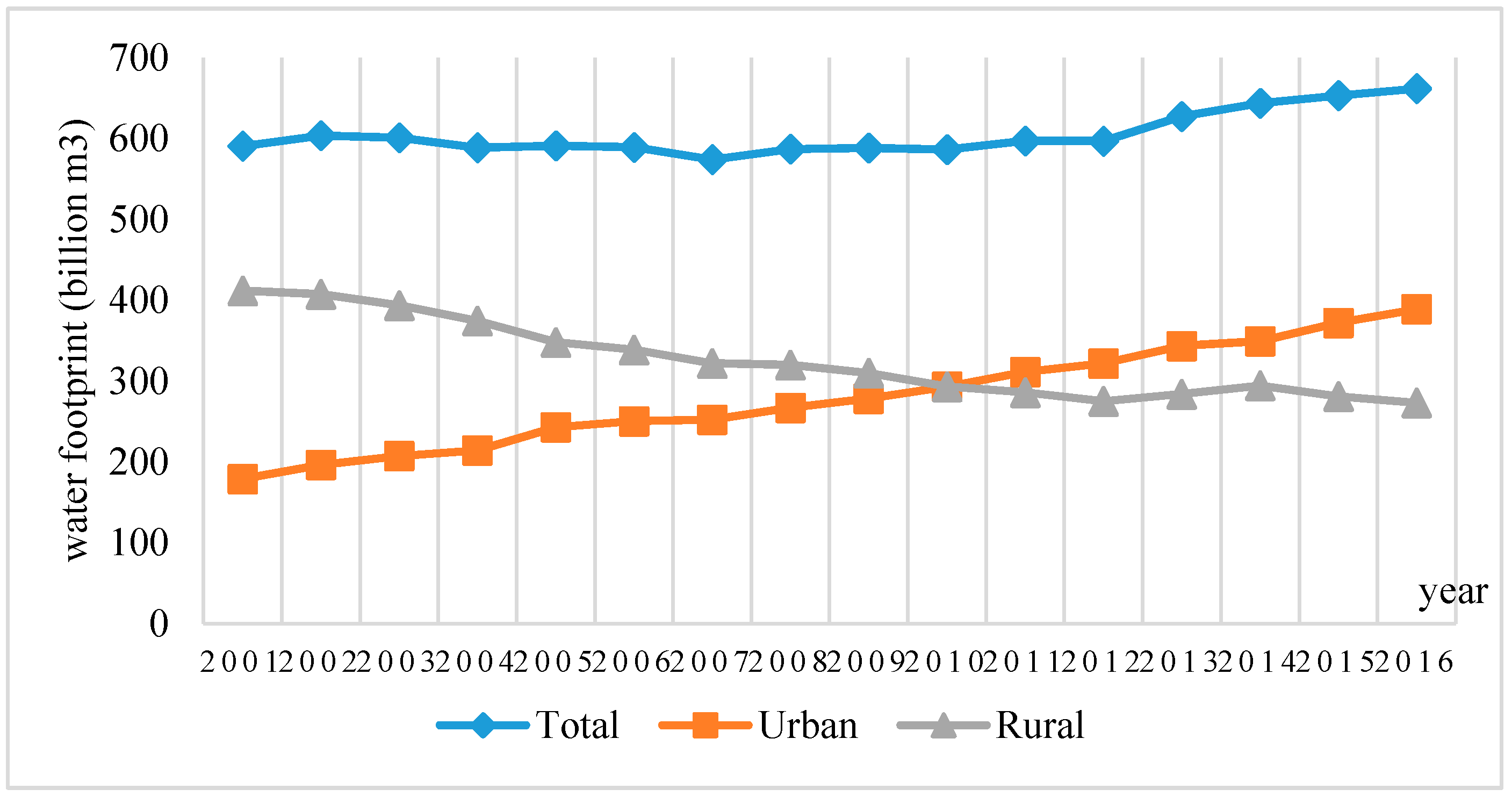
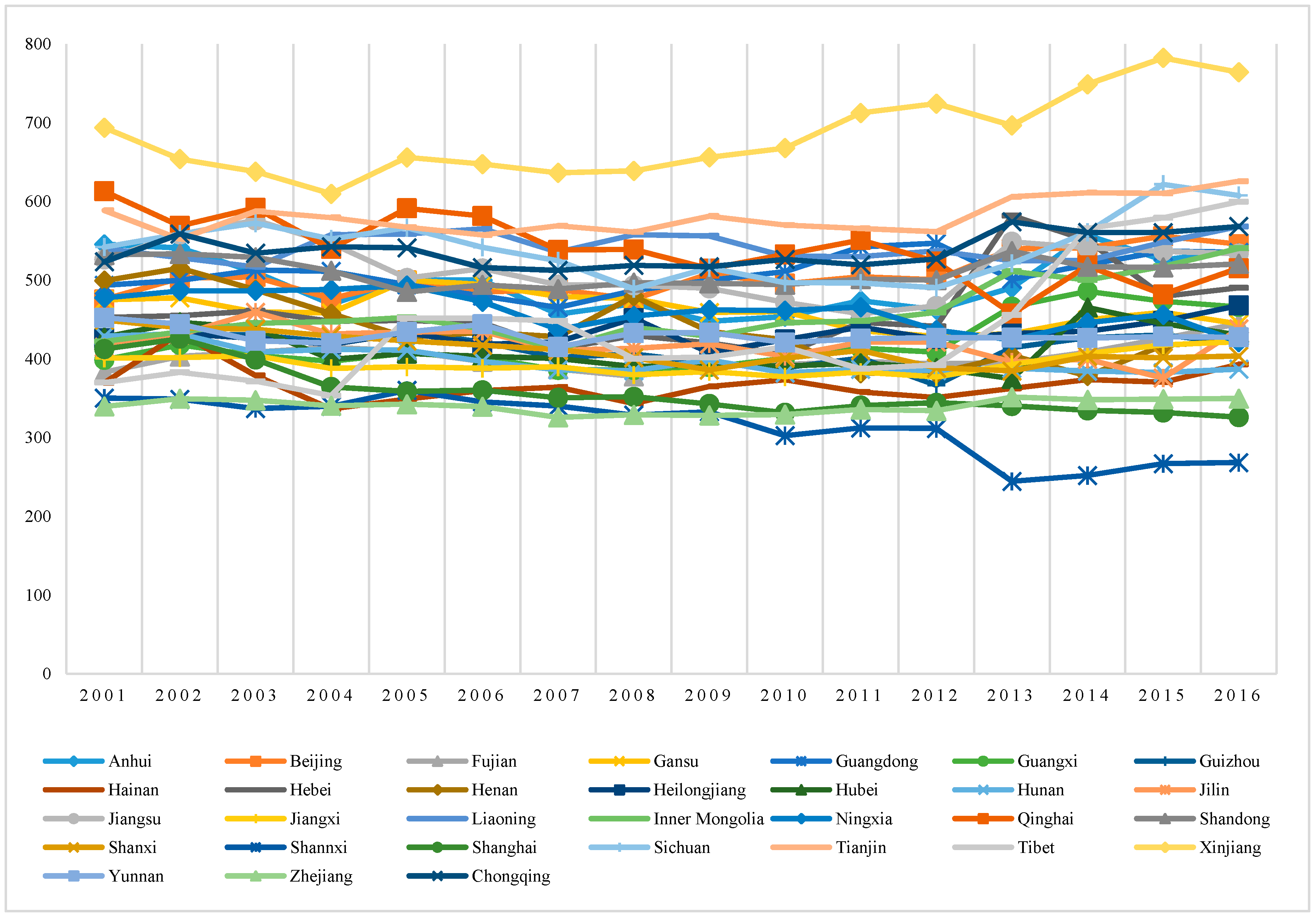
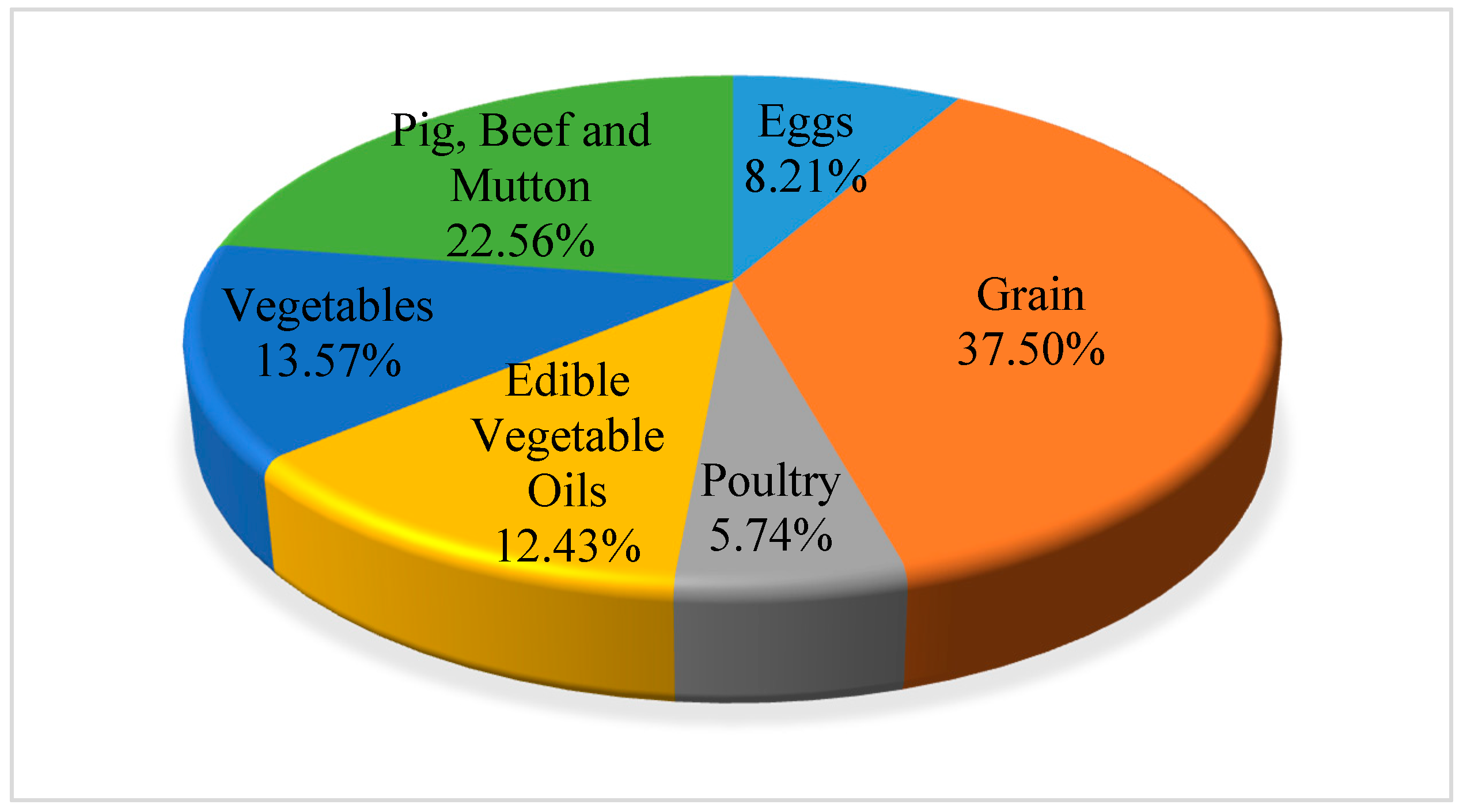
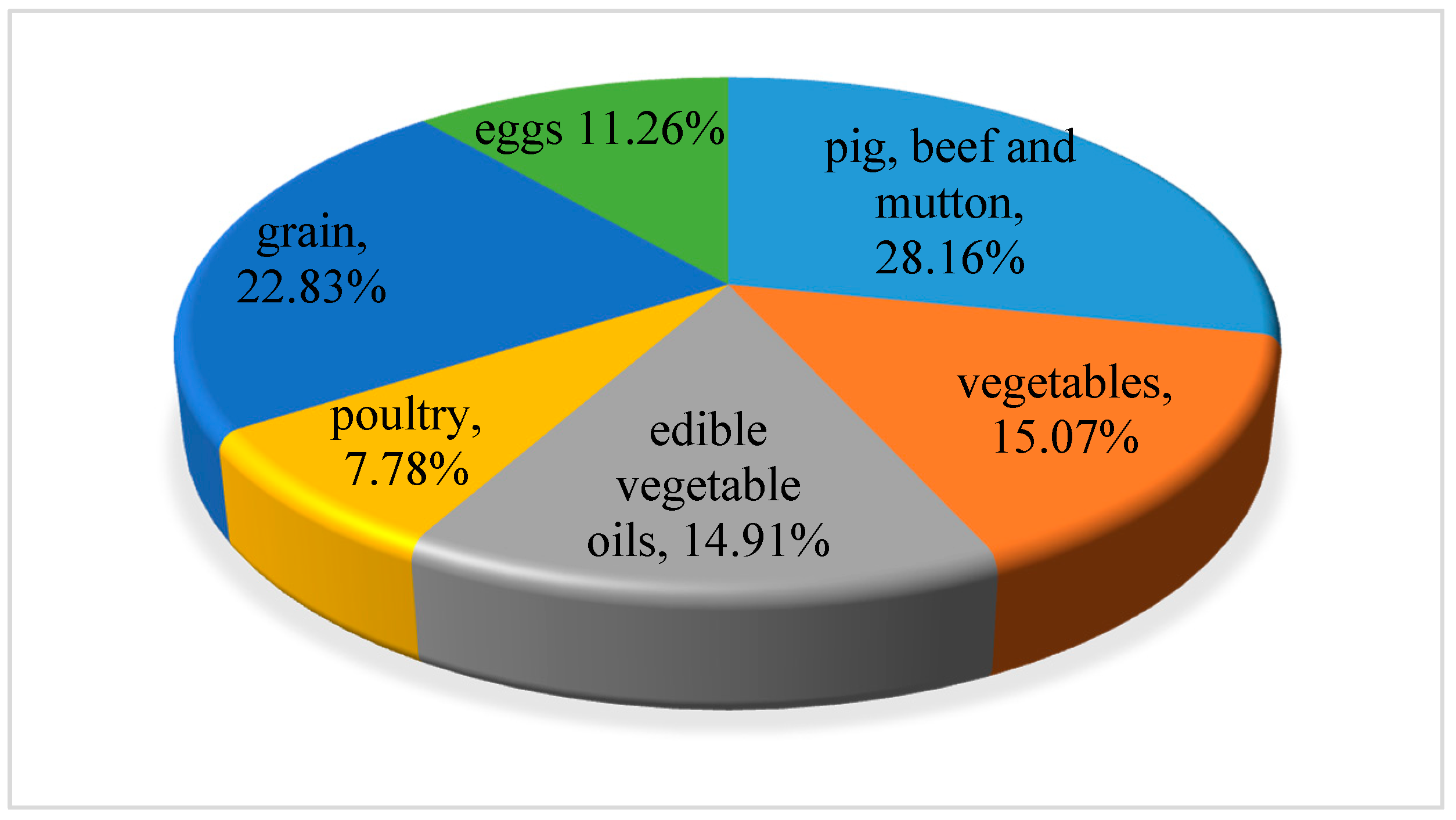
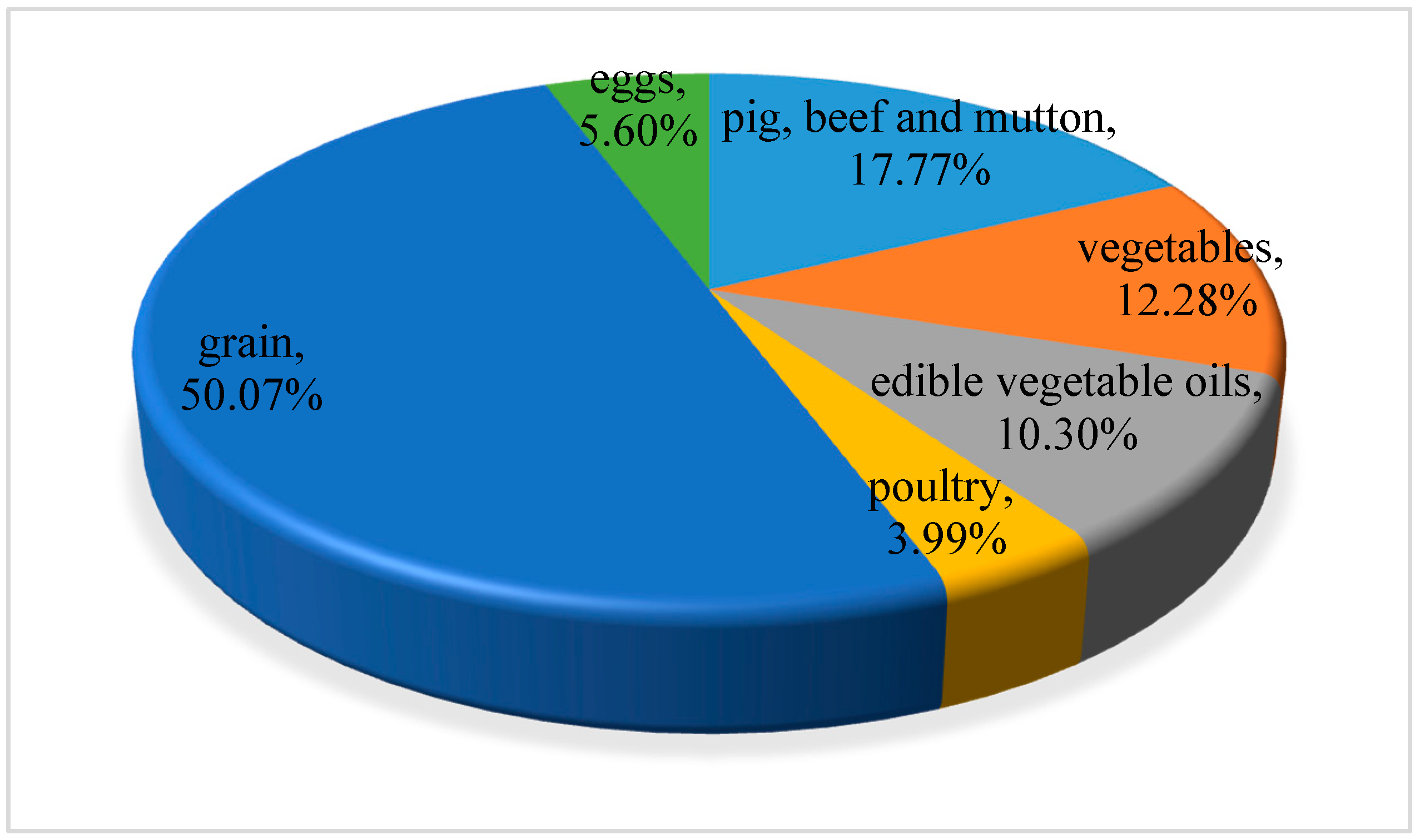
| Agricultural Categories | Products | Water Footprint |
|---|---|---|
| Crop products | Rice | Directly from report No. 47 |
| Wheat | Directly from report No. 47 | |
| Corn | Directly from report No. 47 | |
| Soybean | Directly from report No. 47 | |
| Potato | Directly from report No. 47 | |
| Vegetables | Average of 20 kinds of vegetables (cabbage, artichokes, asparagus, lettuce and chicory, spinach, tomato, cauliflower and broccoli, squash and bottle gourd, cucumber, eggplant, onion and onion, dried onion, garlic, green beans, peas, beans, carrots and white radish, corn, and other fresh vegetables) | |
| Edible vegetable oil | Average of 11 kinds of vegetable oil (soybean oil, peanut oil, palm oil, olive oil, castor oil, sunflower oil, rapeseed oil, sesame oil, cottonseed oil, linseed oil, corn oil) | |
| Animal products | Pork, beef, mutton, poultry and eggs | According to the ratio with the national average which was from report No. 48 |
| Water Footprint Structure | Eggs | Grain | Poultry | Edible Vegetable Oil | Vegetables | Pig, Beef and Mutton | Total | Proportion |
|---|---|---|---|---|---|---|---|---|
| Green water | 566.28 | 2062.67 | 396.52 | 999.08 | 822.23 | 1868.64 | 6715.42 | 69.36% |
| Blue water | 57.82 | 846.23 | 39.35 | 47.08 | 35.77 | 129.12 | 1155.38 | 11.93% |
| Gray water | 170.56 | 721.78 | 119.42 | 156.89 | 455.66 | 186.76 | 1811.06 | 18.71% |
| Year | Eggs | Grain | Poultry | Edible Vegetable Oil | Vegetables | Pig, Beef and Mutton |
|---|---|---|---|---|---|---|
| 2001 | 41.5 | 276.06 | 23.21 | 60.71 | 83.75 | 105.48 |
| 2002 | 42.51 | 271.64 | 26.71 | 63.64 | 85.3 | 113.97 |
| 2003 | 44.95 | 260.68 | 28.03 | 60.84 | 85.41 | 121.24 |
| 2004 | 42.94 | 254.36 | 26.38 | 58.39 | 85.89 | 120.89 |
| 2005 | 45.13 | 237.27 | 31.59 | 63.32 | 82.68 | 131.16 |
| 2006 | 46.88 | 232.36 | 30.23 | 64.01 | 82.42 | 133.29 |
| 2007 | 46 | 223.31 | 31.22 | 66.91 | 82.06 | 124.71 |
| 2008 | 50.19 | 221.06 | 34.06 | 71.97 | 85.6 | 124.25 |
| 2009 | 50.45 | 213.42 | 34.8 | 71.08 | 84.02 | 134.71 |
| 2010 | 49.2 | 208.63 | 36.07 | 70.07 | 82.35 | 140.12 |
| 2011 | 52.12 | 201.38 | 39.95 | 77.97 | 81.35 | 144.44 |
| 2012 | 55.08 | 194.71 | 40.71 | 79.68 | 80.01 | 146.83 |
| 2013 | 52.31 | 212.67 | 37.31 | 95.6 | 76.45 | 153.22 |
| 2014 | 54.17 | 207.56 | 41.66 | 104.34 | 78.18 | 157.85 |
| 2015 | 59.42 | 209.32 | 44.63 | 97.8 | 77.71 | 164.41 |
| 2016 | 61.8 | 206.26 | 48.73 | 96.74 | 80.49 | 167.94 |
© 2019 by the authors. Licensee MDPI, Basel, Switzerland. This article is an open access article distributed under the terms and conditions of the Creative Commons Attribution (CC BY) license (http://creativecommons.org/licenses/by/4.0/).
Share and Cite
Zhang, Y.; Tian, Q.; Hu, H.; Yu, M. Water Footprint of Food Consumption by Chinese Residents. Int. J. Environ. Res. Public Health 2019, 16, 3979. https://doi.org/10.3390/ijerph16203979
Zhang Y, Tian Q, Hu H, Yu M. Water Footprint of Food Consumption by Chinese Residents. International Journal of Environmental Research and Public Health. 2019; 16(20):3979. https://doi.org/10.3390/ijerph16203979
Chicago/Turabian StyleZhang, Yu, Qing Tian, Huan Hu, and Miao Yu. 2019. "Water Footprint of Food Consumption by Chinese Residents" International Journal of Environmental Research and Public Health 16, no. 20: 3979. https://doi.org/10.3390/ijerph16203979
APA StyleZhang, Y., Tian, Q., Hu, H., & Yu, M. (2019). Water Footprint of Food Consumption by Chinese Residents. International Journal of Environmental Research and Public Health, 16(20), 3979. https://doi.org/10.3390/ijerph16203979





